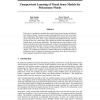Free Online Productivity Tools
i2Speak
i2Symbol
i2OCR
iTex2Img
iWeb2Print
iWeb2Shot
i2Type
iPdf2Split
iPdf2Merge
i2Bopomofo
i2Arabic
i2Style
i2Image
i2PDF
iLatex2Rtf
Sci2ools
NIPS
2008
2008
Unsupervised Learning of Visual Sense Models for Polysemous Words
Polysemy is a problem for methods that exploit image search engines to build object category models. Existing unsupervised approaches do not take word sense into consideration. We propose a new method that uses a dictionary to learn models of visual word sense from a large collection of unlabeled web data. The use of LDA to discover a latent sense space makes the model robust despite the very limited nature of dictionary definitions. The definitions are used to learn a distribution in the latent space that best represents a sense. The algorithm then uses the text surrounding image links to retrieve images with high probability of a particular dictionary sense. An object classifier is trained on the resulting sense-specific images. We evaluate our method on a dataset obtained by searching the web for polysemous words. Category classification experiments show that our dictionarybased approach outperforms baseline methods.
| Added | 29 Oct 2010 |
| Updated | 29 Oct 2010 |
| Type | Conference |
| Year | 2008 |
| Where | NIPS |
| Authors | Kate Saenko, Trevor Darrell |
Comments (0)

